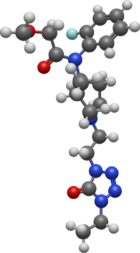Chemistry:Brifentanil
 | |
 | |
| Clinical data | |
|---|---|
| Other names | Brifentanil |
| ATC code |
|
| Identifiers | |
| |
| CAS Number | |
| PubChem CID | |
| ChemSpider | |
| UNII | |
| ChEMBL | |
| Chemical and physical data | |
| Formula | C20H29FN6O3 |
| Molar mass | 420.489 g·mol−1 |
| 3D model (JSmol) | |
| |
| |
| (verify) | |
Brifentanil (A-3331) is an opioid analgesic that is an analogue of fentanyl and was developed in the early 1990s.[1]
Brifentanil is most similar to highly potent, short-acting fentanyl analogues such as alfentanil. The effects of brifentanil are very similar to those of alfentanil, with strong but short lasting analgesia and sedation, and particularly notable itching and respiratory depression.[2]
Side effects of fentanyl analogs are similar to those of fentanyl itself, which include itching, nausea and potentially serious respiratory depression, which can be life-threatening. Fentanyl analogs have killed hundreds of people throughout Europe and the former Soviet republics since the most recent resurgence in use began in Estonia in the early 2000s, and novel derivatives continue to appear.[3]
References
- ↑ "Synthesis and pharmacological evaluation of a series of new 3-methyl-1,4-disubstituted-piperidine analgesics". Journal of Medicinal Chemistry 33 (10): 2876–82. October 1990. doi:10.1021/jm00172a032. PMID 2170652.
- ↑ "[Ventilatory response to hypoxia and hypercapnia after intravenous brifentanyl (a new synthetic narcotic)]" (in Italian). Minerva Anestesiologica 57 (9): 618. September 1991. PMID 1798508.
- ↑ "Fentanyls: Are we missing the signs? Highly potent and on the rise in Europe". The International Journal on Drug Policy 26 (7): 626–31. July 2015. doi:10.1016/j.drugpo.2015.04.003. PMID 25976511. http://www.ijdp.org/article/S0955-3959%2815%2900097-3/abstract.
 |

